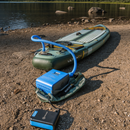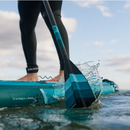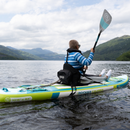1 Fin Vs 3 Fin Paddle Board: Which Rules the Waves?

Are you someone whose heart beats faster at the thought of slicing through the water on a stand up paddle board? If you're passionate about paddle boarding, the equipment you use significantly impacts your experience on the water. And you know that the number of fins can significantly impact your board's performance. The central question here is, should you choose a 1 fin or 3 fin paddle board? Let's set sail and navigate through the particulars to find the best fit for you. We're here to clear the waves of confusion and help you make an informed decision.
The Anatomy of a Paddle Board Fin
Before we delve into the paddle boarding gear specifics, it's essential to familiarize ourselves with a crucial component that plays a significant role in your paddle boarding experience: the paddle board fin.
Just like a ship's rudder, the paddle board fin is positioned underneath the paddle board, which significantly influences the board's behavior and responsiveness.
But what does a paddle board fin do? At its core, it performs three main functions:
- Stability: Fins help stabilize the paddle board by reducing the board's sideways drift, especially when dealing with wind or current. They act as an anchor that cuts through the water, offering you a more steady and enjoyable ride.
- Maneuverability: The ability to control your board’s direction, make quick turns, or correct its course in the water largely depends on the fin. A properly positioned fin allows for more effortless steering, thereby improving maneuverability.
- Control: Fins significantly impact your paddle board’s tracking, which is the board's ability to maintain a straight line when paddling. Without a fin, your board would be much more challenging to control, continually veering off course.
Fins come in a plethora of shapes and sizes, each offering different performance traits. Larger fins provide better stability and tracking but less maneuverability, while smaller fins offer the opposite—more agility but less stability.

Features of a 1 Fin Paddle Board
A single-fin paddle board, often equipped with a large center fin, delivers impressive tracking performance, making it suitable for flatwater paddling or distance touring.
The lone fin design reduces water resistance, resulting in less drag and faster speeds. It cuts through the serene waters like a hot knife through butter, making straight-line paddling seem like a breeze. This setup also simplifies maintenance since there's only one fin to care for.
Features of a 3 Fin Paddle Board
In a comparison of 3 fins vs 1 fin paddle board, a three-fin board, or 'thruster' setup, includes three equally-sized fins positioned in a triangular arrangement. This setup provides excellent lateral stability, particularly useful in choppy waters or when wave riding. The three fins enhance maneuverability, allowing the board to make rapid directional adjustments.
With a three fin setup, you become the master of swift turns and quick directional changes. So, if you're ready to embrace the thrill, grab your triple-fin paddle board and let the adventure begin. With three fins under your board, you're not just paddle boarding, you're creating epic water stories!

1 Fin Vs 3 Fin Paddle Board: The Differences
When we discuss 1 fin vs 3 fin paddle boards, the distinction becomes more apparent through comparison:
| Factors | 1 Fin | 3 Fins |
|---|---|---|
| Speed | With reduced drag, single fin boards are typically faster. | More drag due to three fins results in slower speed. |
| Stability | Single fin boards offer less lateral stability. | Three fin boards provide enhanced lateral stability, beneficial in rough waters. |
| Maneuverability | Lower maneuverability due to a single central fin. | High maneuverability, allowing quick turns and direction changes. |
| Maintenance | Easier, with just one fin to care for. | More challenging, with three fins needing attention. |
| Adaptability | Single fin boards are excellent for flatwater touring or racing. | Three fin boards excel in surfing or navigating through choppy waters. |
Factors to Consider Before Deciding
Before choosing your fin setup, consider these factors:
- Skill Level: Novices may find a 3 fin paddle board easier for maintaining balance. As you gain more experience, you may appreciate the speed and tracking offered by a single-fin setup.
- Water Body: For flat, calm water bodies, a 1 fin setup excels. However, in surf or choppy waters, the stability of a 3 fin setup can be advantageous.
- Paddle Boarding Styles: If you're into long-distance touring or racing, consider a 1 fin paddle board. For surfing or whitewater paddling, a 3 fin setup can provide the necessary maneuverability.

How to Set Up Your Fin?
Understanding how to set up your fin correctly is as crucial as choosing the right fin setup. It can greatly impact your paddle board's performance.
So, when deciding between a 1 fin vs 3 fin paddle board, remember to consider your skill level, the water body, and your paddle boarding style. Both options have their strengths, and the choice ultimately depends on your personal preference and boarding objectives. There's no one-size-fits-all answer.
Visit iROCKER's blog for more! You'll not only gain invaluable insights into the world of paddle boarding but also join a community of enthusiastic paddle boarders just like you. So, what are you waiting for? The waves are calling. Happy paddling!






